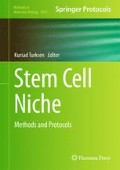Abstract
Skeletal muscle tissue has a remarkable capability of regenerating in pathological conditions or after injury. The principal muscle stem cells, satellite cells, are responsible for this prompt and efficient process. Normally quiescent in their niches underneath the basal lamina of each muscle fiber, satellite cells become activated to repair or form new fibers. Ideally, healthy donor stem cells could be transplanted to regenerate the skeletal muscle tissue to repair a genetic defect. However, to be efficient, cell grafting requires modulation of the host muscle environment to allow homing of, and regeneration by, donor satellite cells. Here, we provide methods to modulate the host mouse muscle environment in order to destroy or preserve the muscle niche before transplanting donor satellite cells. We also describe methods to investigate donor-derived muscle regeneration and self-renewal.
Access this chapter
Tax calculation will be finalised at checkout
Purchases are for personal use only
References
Charge SB, Rudnicki MA (2004) Cellular and molecular regulation of muscle regeneration. Physiol Rev 84(1):209–238
Mauro A (1961) Satellite cell of skeletal muscle fibers. J Biophys Biochem Cytol 9:493–495
Boldrin L, Muntoni F, Morgan JE (2010) Are human and mouse satellite cells really the same? J Histochem Cytochem 58(11):941–955. doi:10.1369/jhc.2010.956201
Boldrin L, Neal A, Zammit PS, Muntoni F, Morgan JE (2012) Donor satellite cell engraftment is significantly augmented when the host niche is preserved and endogenous satellite cells are incapacitated. Stem Cells 30(9):1971–1984. doi:10.1002/stem.1158
Harris JB (2003) Myotoxic phospholipases A2 and the regeneration of skeletal muscles. Toxicon 42(8):933–945
McGeachie JK, Grounds MD, Partridge TA, Morgan JE (1993) Age-related changes in replication of myogenic cells in mdx mice: quantitative autoradiographic studies. J Neurol Sci 119(2):169–179
Emery AE (2002) The muscular dystrophies. Lancet 359(9307):687–695. doi:S0140-6736(02)07815-7, [pii] 10.1016/S0140-6736(02)07815-7
Malerba A, Sharp PS, Graham IR, Arechavala-Gomeza V, Foster K, Muntoni F, Wells DJ, Dickson G (2011) Chronic systemic therapy with low-dose morpholino oligomers ameliorates the pathology and normalizes locomotor behavior in mdx mice. Mol Ther 19(2):345–354. doi:10.1038/mt.2010.261
Partridge TA, Morgan JE, Coulton GR, Hoffman EP, Kunkel LM (1989) Conversion of mdx myofibres from dystrophin-negative to -positive by injection of normal myoblasts. Nature 337(6203):176–179
Boldrin L, Zammit PS, Muntoni F, Morgan JE (2009) Mature adult dystrophic mouse muscle environment does not impede efficient engrafted satellite cell regeneration and self-renewal. Stem Cells 27(10):2478–2487. doi:10.1002/stem.162
Kelly R, Alonso S, Tajbakhsh S, Cossu G, Buckingham M (1995) Myosin light chain 3F regulatory sequences confer regionalized cardiac and skeletal muscle expression in transgenic mice. J Cell Biol 129(2):383–396
Tajbakhsh S, Bober E, Babinet C, Pournin S, Arnold H, Buckingham M (1996) Gene targeting the myf-5 locus with nlacZ reveals expression of this myogenic factor in mature skeletal muscle fibres as well as early embryonic muscle. Dev Dyn 206(3):291–300
Beauchamp JR, Heslop L, Yu DS, Tajbakhsh S, Kelly RG, Wernig A, Buckingham ME, Partridge TA, Zammit PS (2000) Expression of CD34 and Myf5 defines the majority of quiescent adult skeletal muscle satellite cells. J Cell Biol 151(6):1221–1234
Blaveri K, Heslop L, Yu DS, Rosenblatt JD, Gross JG, Partridge TA, Morgan JE (1999) Patterns of repair of dystrophic mouse muscle: studies on isolated fibers. Dev Dyn 216(3):244–256
Collins CA, Olsen I, Zammit PS, Heslop L, Petrie A, Partridge TA, Morgan JE (2005) Stem cell function, self-renewal, and behavioral heterogeneity of cells from the adult muscle satellite cell niche. Cell 122(2):289–301
Collins CA, Zammit PS (2009) Isolation and grafting of single muscle fibres. Methods Mol Biol 482:319–330. doi:10.1007/978-1-59745-060-7_20
Gross JG, Bou-Gharios G, Morgan JE (1999) Potentiation of myoblast transplantation by host muscle irradiation is dependent on the rate of radiation delivery. Cell Tissue Res 298(2):371–375
Neal A, Boldrin L, Morgan JE (2012) The satellite cell in male and female, developing and adult mouse muscle: distinct stem cells for growth and regeneration. PLoS One 7(5):e37950. doi:10.1371/journal.pone.0037950
Hoffman EP, Morgan JE, Watkins SC, Partridge TA (1990) Somatic reversion/suppression of the mouse mdx phenotype in vivo. J Neurol Sci 99(1):9–25
Gross JG, Morgan JE (1999) Muscle precursor cells injected into irradiated mdx mouse muscle persist after serial injury. Muscle Nerve 22(2):174–185
Acknowledgments
The authors thank Miss Rowan Asfahani for the pictures presented in Fig. 1. This work was supported by Muscular Dystrophy Campaign (grant code RA3/776) and Wellcome Trust University Award (grant code 08241/Z/07/Z).
Author information
Authors and Affiliations
Editor information
Editors and Affiliations
Rights and permissions
Copyright information
© 2013 Springer Science+Business Media, LLC
About this protocol
Cite this protocol
Boldrin, L., Morgan, J.E. (2013). Modulation of the Host Skeletal Muscle Niche for Donor Satellite Cell Grafting. In: Turksen, K. (eds) Stem Cell Niche. Methods in Molecular Biology, vol 1035. Humana Press, Totowa, NJ. https://doi.org/10.1007/978-1-62703-508-8_15
Download citation
DOI: https://doi.org/10.1007/978-1-62703-508-8_15
Published:
Publisher Name: Humana Press, Totowa, NJ
Print ISBN: 978-1-62703-507-1
Online ISBN: 978-1-62703-508-8
eBook Packages: Springer Protocols

